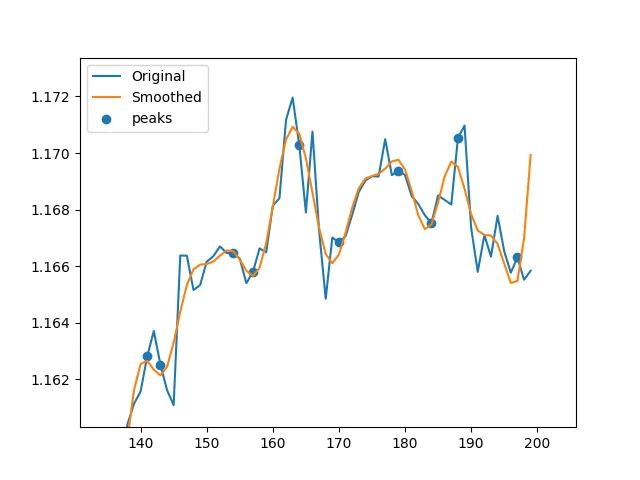基本上我正在编写一个峰值查找函数,需要能够在基准测试中击败
它基本上使用快速傅里叶变换(FFT)平滑数据,然后取导数以找到平滑数据的最小和最大索引,然后在未平滑的数据中找到相应的峰值。由于某些平滑效果,有时它找到的峰值不理想,因此我运行此for循环来搜索由指定的边界之间每个索引的更高或更低点。我需要帮助将此
scipy.argrelextrema。 这是我使用的数据和代码链接:
https://drive.google.com/open?id=1U-_xQRWPoyUXhQUhFgnM3ByGw-1VImKB
如果此链接已过期,您可以在Dukascopy银行的在线历史数据下载器中找到数据。import numpy as np
import pandas as pd
import matplotlib.pyplot as plt
data = pd.read_csv('EUR_USD.csv')
data.columns = ['Date', 'open', 'high', 'low', 'close','volume']
data.Date = pd.to_datetime(data.Date, format='%d.%m.%Y %H:%M:%S.%f')
data = data.set_index(data.Date)
data = data[['open', 'high', 'low', 'close']]
data = data.drop_duplicates(keep=False)
price = data.close.values
def fft_detect(price, p=0.4):
trans = np.fft.rfft(price)
trans[round(p*len(trans)):] = 0
inv = np.fft.irfft(trans)
dy = np.gradient(inv)
peaks_idx = np.where(np.diff(np.sign(dy)) == -2)[0] + 1
valleys_idx = np.where(np.diff(np.sign(dy)) == 2)[0] + 1
patt_idx = list(peaks_idx) + list(valleys_idx)
patt_idx.sort()
label = [x for x in np.diff(np.sign(dy)) if x != 0]
# Look for Better Peaks
l = 2
new_inds = []
for i in range(0,len(patt_idx[:-1])):
search = np.arange(patt_idx[i]-(l+1),patt_idx[i]+(l+1))
if label[i] == -2:
idx = price[search].argmax()
elif label[i] == 2:
idx = price[search].argmin()
new_max = search[idx]
new_inds.append(new_max)
plt.plot(price)
plt.plot(inv)
plt.scatter(patt_idx,price[patt_idx])
plt.scatter(new_inds,price[new_inds],c='g')
plt.show()
return peaks_idx, price[peaks_idx]
它基本上使用快速傅里叶变换(FFT)平滑数据,然后取导数以找到平滑数据的最小和最大索引,然后在未平滑的数据中找到相应的峰值。由于某些平滑效果,有时它找到的峰值不理想,因此我运行此for循环来搜索由指定的边界之间每个索引的更高或更低点。我需要帮助将此
for循环向量化!我不知道如何做。没有for循环,我的代码比scipy.argrelextrema快约50%,但是for循环会减慢速度。因此,如果我能找到一种将其向量化的方法,它将是一个非常快速且非常有效的scipy.argrelextrema替代方法。这两个图像分别表示没有和有for循环的数据。

